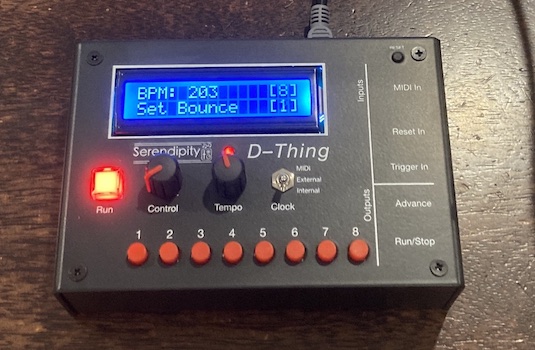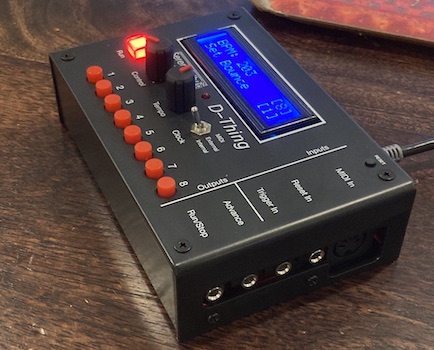
D-Thing
Email me at serendipity.synth@gmail.com with any questions or comments, or if you are interested in obtaining a device.

|

|
The D-Thing is a device that adds significant capabilities to the DFAM (or Edge) sequencer, such as:
- MIDI integration — clocking and individual step play,
- Reset — manual, via CV or via MIDI,
- Variations in the step order — Forward, Reverse, Bounce, Odds & Evens, Shuffle, Random and Custom,
- Changing the sequence length — 1 to 8 steps (up to 16 steps for a custom step order),
- Step repeat — assign a play count of up to 8 times to any step,
- Off-grid timing — swing beat as well as arbitrary shifts away from the beat.
The D-Thing Quick Start guide can be found here.
The D-Thing Firmware Update guide can be found here.
Demo
The following video briefly shows the basic functions (using the internal clock).
Review
Here is a detailed review of the original version of the DFAM Thing by Melbourne artist Bribery.
Connections
Integrating the DFAM Thing with the DFAM and other gear is via two CV outputs, two CV inputs and a MIDI input. These are all on the right hand side of the device so as to not interfere with operating the controls.
Outputs
- Advance: connect to the ADV/CLOCK input on the DFAM so the DFAM Thing can drive the DFAM sequencer. This is the minimum required connection between the DFAM and the DFAM Thing.
- Run/Stop: optionally connect this output to the DFAM’s RUN/STOP input, so the DFAM Thing can control starting and stopping of the sequencer. However, although a high signal on the DFAM’s RUN/STOP input will start the sequencer, it will not trigger the envelopes, so to make use of this feature you will also need to mult the Advance output of the DFAM Thing to the TRIGGER in on the DFAM. If you setup so the DFAM will start on step 1, the two devices will be in sync with regard to step numbering.
- Alternative Run/Stop: because of the limitation discussed in the previous point, I have added the option to make the Run/Stop output act as a cycle indicator instead, sending a pulse each time the sequencer pattern returns to its starting step. To toggle this option, keep the Control encoder pressed while the unit starts up. To know the current state, look for the ’*’ when the unit reports the firmware version — if present, the alternative mode is enabled.
Inputs
- Reset In: a high to this input will cause a reset to (the DFAM Thing’s idea of) step 1.
- Trigger In: when the clocking is external, clock steps are determined by pulses at this input.
- MIDI In: a 5-pin DIN MIDI input for MIDI note, clock & CC messages.
Controls
|
Run Press to start or stop the sequencer. Tap while running to reset to step 1. Control An encoder for selecting modes and other funtions. Rotate to select, click to apply. Tempo A potentiometer for setting the speed of the internal clock. Clock A switch for selecting between internal, external and MIDI clocking of the steps. |
Buttons 1-8 8 buttons for setting the sequence length in the standard modes, but also for manually playing particular steps, defining a custom sequence, or setting clock multiply/divide factors. Steps An encoder on the Eurorack modules for step selection, in place of the individual buttons found in the standalone device. Reset A small button for rebooting the controller. Contrast A trimmer pot accessible from the rear for adjusting the LCD contrast. |
Clocking the DFAM
Aligning the DFAM and the DFAM Thing
- On startup it is necessary to ensure that the DFAM and the DFAM Thing agree on the first step of a sequence. The easiest way to achieve this is by manually advancing the DFAM sequencer to the first step, rotating the Control encoder until Align Step 1 is displayed, and clicking.
Internal Clock
- When running in this mode, triggers are sent from the Advance output at a rate detemined by the Tempo potentiometer (and shown on the LCD).
External Clock
- When running in this mode, as triggers are received on the Trigger In input, they are passed to the Advance output.
MIDI Clock
- Timing is determined by incoming clock messages over MIDI.
- Start, Stop and Continue messages are used to control the Run state of the DFAM Thing, with Start always beginning from step 1 (according to the DFAM Thing), and Continue from whatever is the current step.
- The MIDI clock input is set to 24 clocks per beat.
- Use of this option is completely independent of the MIDI Mode sequencer option described below.
Clock Multiply and Divide
When either Internal or MIDI clock is selected, pressing and holding the Control encoder and clicking one of the numbered buttons changes the clock speed as follows:
- normal speed,
- double speed,
- triple speed,
- quadruple speed,
- normal speed,
- half speed,
- one third speed,
- one quarter speed.
When a clock factor is applied, the BPM is shown with an asterisk on the display.
Playing the DFAM steps
Sequencer modes (patterns)
- Normal: play the steps in order, as per standard DFAM operation,
- Reverse: play the steps in reverse order,
- Bounce: first move through the steps in a forward direction, then bounce back and play them in the reverse direction,
- Odds & Evens: first play just the odd steps in a forward direction, then play just the even steps,
- Shuffle: create a random permutation of the steps, and repeat this particular permutation. A new permutation is created each time this option is selected.
- Random: play a completely random step each beat,
- Custom: play following a saved sequence of up to 16 steps. A custom sequence is entered by rotating the Control encoder and selecting Save Custom, followed by pressing the numbered buttons as desired to record the corresponding steps.
The number of steps (other than for a custom sequence) can be set to anything from 1 to 8 by clicking the corresponding numbered button. The length chosen is displayed at the top right of the screen.
Other modes
Multistep: enter the multistep menu (see below).
Swing: toggle the swing beat.
Microtiming: enter the microtiming menu (see below).
Play as Keys: use the buttons to trigger particular steps when pressed.
Tap Tempo: three or more presses of any of the buttons will determine the rate of the Internal clock. Pressing the control encoder a second time, or turning the tempo control will cancel Tap Tempo mode.
MIDI Mode
note messages/voltages correspond to specific steps as follows:
- Any C = step 1
- Any D = step 2
- and so on for E, F, G, A, B♭ and B.
If the D-Thing is running, the selected clock source will determine the triggering of the note, otherwise the note will trigger only when played.
When in MIDI mode you can press one of the numbered buttons to change the MIDI channel. Buttons 1 to 7 set it to that particular channel, and button 8 sets it to omni mode. The selected channel is shown on the screen, and persists across restarts.
It is important to note the distinction between MIDI Mode and the MIDI Clock option. MIDI Mode is purely for using note messages to play particular steps on the DFAM sequencer. MIDI Start, Stop and Continue messages will not affect the Run state of the D-Thing unless the Clock switch is set to MIDI Clock.
MIDI Control
New in firmware 1.3 of the standalone D-Thing is support for MIDI CCs.
- The MIDI CC numbers 16, 17 and 18 control pattern length, pattern type and clock multiplier respectively.
- The D-Thing uses the high byte of the control value, so the changes occur at 0, 16, 32, 48 etc. This works better when controlling by a knob, and makes no difference when controlling by computer.
- MIDI CC message support is only available in MIDI clock mode.
System Configuration
Holding down the Control encoder on startup (or after pressing reset) allows changing various device settings. Each setting is presented in order, and a selection is made by rotating and clicking the Control encoder. Currently these settings control
- Whether the output at the Run socket is the Run/Stop state or a Cycle pulse (called alt Run),
- Whether the internal clock should provide finer control over a smaller range, or support speeds right up to 5000bpm,
- The PPQN for the MIDI clock response (6, 12 or 24).
What’s that little switch?
Unfortunately the MIDI circuit interferes with programming the Nano via USB, so the small switch is there to disconnect the MIDI circuit when programming the chip. (It also possible of course to remove the chip from the board in order to program it.)
If you accidentally flick the switch then MIDI will not function. This is the first thing to check should MIDI stop working.
The process for updating the firmware is described in the Firmware Update guide.
New Features in Firmware 1.5
Swing and Microtiming
Swing timing can be selected using the Control encoder, and is simply toggled on and off. When on, every second step is delayed by 1/3 of a beat.
Microtiming has its own submenu for programming and control. When Microtiming is selected, you can use the submenu to:
Set: Keep a numbered button pressed and rotate the encoder to set the micro-timing shift for the corresponding step in units of 1/180th of a beat. The maximum deviation is 1/3 late (a positive value) or early (a negative value). Click the encoder while the button is held to return the deviation to zero.
Clear: Return all steps to 0 deviation.
Save: Save the current deviations.
Restore: Restore the last saved deviations.
Return: Leave the submenu (all settings will remain active).
Here is a demo of these features using the Behringer Edge.
Multistep
Multistep also has its own submenu for programming and control. When Multistep is selected, you can use the submenu to:
- Set: Keep a numbered button pressed and rotate the encoder to set the play count for the corresponding step (from 1 to 8). Click the encoder while the button is held to return the count to 1.
The other options behave in the same way as for Microtiming.
Here is a demo of these features using the Behringer Edge.